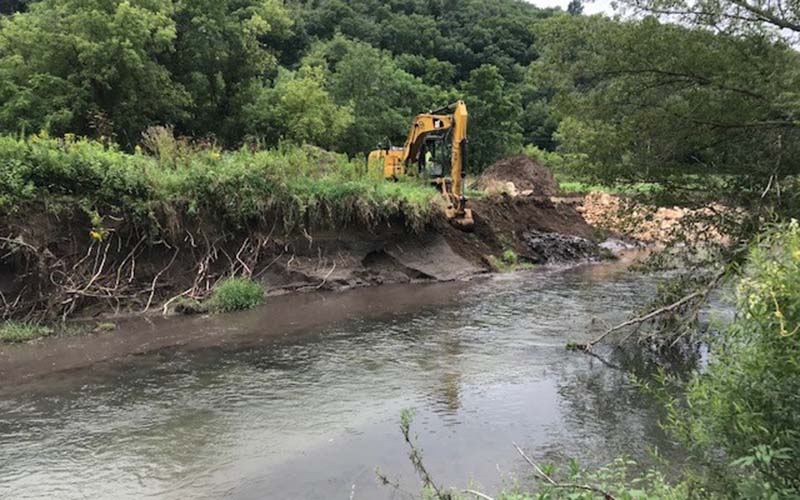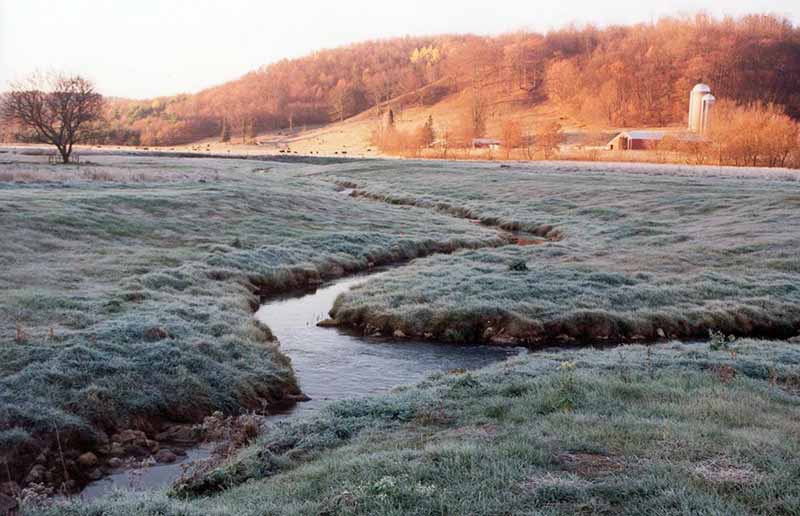Duke Welter is the Driftless area restoration outreach coordinator for Trout Unlimited in Viroqua.
In the period prior to European settlement, Driftless area valley floors were wet prairies or grasslands with deep-rooted grasses that held the soil in place. The streams flowed from cold springs and had gravel bottoms. As settlers broke the sod on the ridgetops, the soil washed off and left blankets of sediment in the valley floors that can range from four to 25 feet thick. Even today, one can see tree stumps at water level that are the remnants of the oaks that were in the valley before the modern era.
Removing the ridgetop sod and hillside trees led to gully erosion of the upland plateaus. At its worst, from 1890 to the 1930s, communities couldn’t keep the roads and bridges open because of the mud and flooding. They were losing their ability to get their milk to the local creameries, threatening an economic crisis for the area. Town and county boards strained to find funds for repairs.

The brand-new United States Soil Conservation Service began the nation’s first-ever watershed conservation project in Coon Valley, Wisconsin in the mid-1930s. The Works Project Administration (WPA) and Civilian Conservation Corps (CCC) came to town and began to replant hillsides, build check dams in gullies, and put in upland contour strips. It was so successful that they stopped 85 percent of the uphill erosion. But sediment was still choking the streams. A survey in 1957 concluded that land use in the region was still so poor that the trout were not likely to persist in future years.
In 1978, the Inland Trout Stamp program began to fund trout habitat work. Wisconsin Department of Natural Resources has worked with Trout Unlimited and local conservation groups to stabilize streambanks and install habits structures. With habitat work and improved land use in the 21st century, classified trout water in the Driftless Area has risen from 4,000 to over 6,000 miles. Still, few of the habitat projects looked at whole watersheds rather than stream segments.
The Driftless Area Restoration Effort project was started in 2005 to be a locally driven effort to protect, restore, and enhance rivers and streams for fish and other aquatic life throughout the Driftless Area. The project was intended to ramp up the scope of watershed restoration in the Driftless Area, expand funding available for restoration, share information, and train people and organizations to build capacity for undertaking restoration in their watershed. Some work was already being done across the region, but, since 2005, restoration spending has increased from $1 million to $7 million per year.

Upland conservation practices have been built in place since the 1930s, but in the last 20 years two key developments have reduced their effectiveness. Since 2007, we have encountered a series of high intensity rain events that have damaged agricultural lands, overwhelmed conservation practices, and flooded communities. At the same time, dramatic increases in corn and soybean prices have led to the loss of conservation practices that farmers had been using. We have also encountered an increase in industrial farming.
Despite the challenges, initiatives like this give me hope. There are many positive impacts of restoration — trout fishing in the Driftless area has a $1.6 billion annual economic impact — and the environmental impacts are undeniable. Trout Unlimited has shown us ways to make a difference across the region.
Learn More
The views and opinions expressed in this interview are those of the authors and do not represent official policy or position of the University of Wisconsin-Madison or the Wisconsin Initiative on Climate Change Impacts.
For More Information
Duke Welter
Driftless Area Restoration Outreach Coordinator
Trout Unlimited in Viroqua